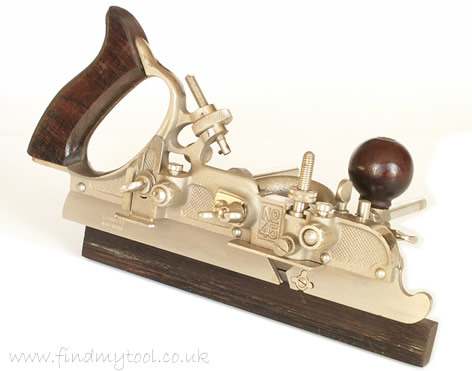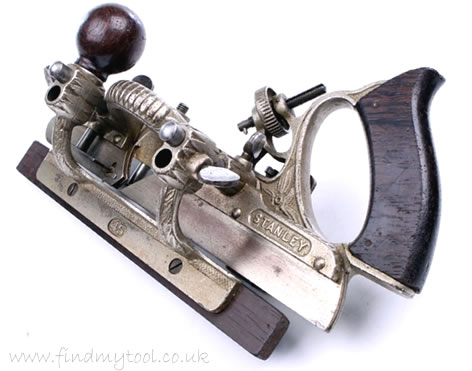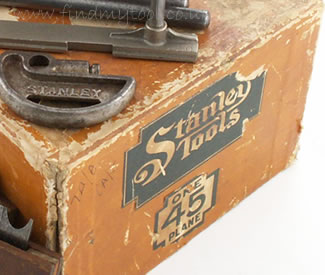

Stanley 45 Plane Review By: I.Ball
Category: Old Multi Planes
Manufacturer: Stanley
Plane Type: Multi-Plane
Model No: 45
The Stanley 45 multi-plane is a tool capable of carrying out a multitude
of tasks. The idea behind the invention of these multi-planes was to
have one multi-purpose plane instead of having 10+ different planes.
The Stanley 45 ("forty-five") plane can perform the following jobs:
The plane is made of three main sections:

The body is the central part of the plane to which everything is connected including
the housing of the chosen plane blade. The body of the plane is fitted with a Rosewood
rear handle and Rosewood front knob.
The sliding section which sits between the body and the fence, is used to support
the wider plane blades in order to help prevent chatter.
The sliding section can
be adjusted if required by sliding it along the arms and locking it in position
with the thumb screws. This may require moving the fence first if the fence is
positioned close to the sliding section.
The fence is used to guide the plane along at an equal distance from the edge of the piece
of wood being planed.

The fence can be adjusted by releasing the thumb screws and
sliding the fence along the arms / rods until at the required distance, the thumb
screws are then tightened to lock the fence in position.
The fence is held on two arms / rods which helps to keep the fence / plane stable
when planing. Towards each end of the fence the eye holes are set with one on top of
each other, this allows the fence to be positioned in a higher or lower position.
The Stanley 45 plane was also equipped with spurs for cross grain work and a depth stop
to assist in setting the depth of cut.
The Stanley 45 can look a little complex and intimidating at first glance. A lot
of the complexity is simply screws and wing nuts which are used to lock a piece
in place.
The plane was originally coated in a nickel plated finish. This finish gave the
plane a bright finish and helped protect the plane from rusting. This nickel plating
is prone to coming off over years of use as such it is common to find Stanley 45
planes with some nickel plate loss.

During the lifetime of the Stanley 45 it went through various stages
of development which led to different Stanley 45 types being sold.
Most of the 45's sold were supplied with approximately 20-24 cutters
with additional cutters available to purchase at extra cost.
These standard cutters consisted of a good range of plough and dado
cutters: 1/8" - 7/8", a good range of beading cutters: 1/8" - 1/2", a
fillister cutter, a slitting cutter, a sash cutter and a match cutter.
The additional Stanley 45 cutters available to buy:
There were additional bases available to buy for the Stanley 45 to offer additional functionality. The extra bases available included:
Each hollow and round set comprised of one hollow, one round and two
blades. The hollow and its cutter will form a round. A round and its
cutter will form a hollow.
The 'nosing tool' base and cutter are intended for forming a complete
half round e.g. shaping stair treads.
These bases are used by removing the sliding section and put the required
base in its place.
The bases were first made in 1886 with the hollow / round cutters carrying
the patent 'Pat'd Feb 23, 1886'.
The Stanley 45 plane is very similar to the
Stanley 46 multi plane
with the main difference being the Stanley 46 is equipped with
a skewed mouth and a corresponding set of skewed blades.

Body:
cast iron
Sliding Section:
cast iron
Fence:
cast iron with a rosewood runner
Blade:
best steel
Handle and knob:
rosewood
Plane finish:
nickel plated

Body:
cast iron
Sliding Section:
cast iron
Fence:
cast iron with a rosewood runner
Blade:
best steel
Handle and knob:
rosewood
Plane finish:
nickel plated

Body:
cast iron
Sliding Section:
cast iron
Fence:
cast iron with a rosewood runner
Blade:
best steel
Handle and knob:
rosewood
Plane finish:
nickel plated

The Stanley 45 Plane Parts List:
1x main body/stock
1x sliding section
1x sliding section thumb screws
1x fence
2x short arms
2x long arms
2x arm screws
1x depth gauge
1x adjustable depth gauge
1x adjustable depth gauge nut
1x beading stop
1x slitting cutter stop
1x slitting cutter thumb screw
1x cam stop
1x cam stop screw
1x cutter clamp with wing nut
1x cutter fine adjustment wheel
1x cutter fine adjustment bolt
2x spurs
17-24 Cutters (depending on type)
The Stanley 45 was presented in a number of different boxes through its manufacturing life, here are some pictures of the boxes:




The Stanley 45 planes are also often found in user made fitted boxes.
Originally the Stanley 45 was advertised in the late 1800's as an 'Adjustable Beading Plane'
(Stanley 45 Plane).
They then went on to be advertised in 1912 as 'Adjustable Beading, Rebate and Matching Plane'
(Stanley 45 Plane).
In the early 1930's the Record 405 Multi-Plane was introduced which was very similar to the
Stanley 45 and kept the name 'Multi-Plane' from the 1930's to 1980's.
The 45 then went on to be advertised in 1939 as 'Stanley "45" Plane' (Stanley 45 Plane).
The Stanley 45 has also been presented at some point in a box labelled Stanley 45 Combination Plane.
In answer to 'Is The Stanley 45 A Combination Plane Or A Multi-Plane?' I would say the answer is
whichever you wish to call it, for me given the many years of changing naming of the Stanley 45
in advertising and given the same plane type of the Record 405 being classed as a multi-plane
for 50 years of manufacturer advertising and 40+ years of further literature I have come to see
it as a multi-plane.
A combination plane under the Record plane indexing and for me (which must be directly or indirectly
from Record plane indexing) and what is shown in a 1939 Stanley catalogue is a plane which sits
between a plough / plow plane
and a multi-plane, "45" or "55" in terms of functionality.
See 'What Is A Combination Plane?'
and 'What Is A Multi Plane?'
for more on this.
1884 - 1958>
1886 - 1939>
Walt - Stanley 45 Knob Question:
The round wooden knob on these planes is frequently broken or missing.
I'd love to hear more details about this (these) knobs.
Some are round with a screw on top. Some have no screw and are threaded
onto a cast iron stud with two flats cast on opposite sides of the stud.
What are the flats for? Why not cast threads on the whole 360° of the stud?
Lastly, what is the diameter of the ball and the shoulder (base) of the ball
for those of us who might want to turn this missing part for our old planes?
Thanks,
Walt
------------
....
Do you have a question/answer or something to share about this tool?
Please Contact Us
(i) This review/article may give warning(s) / advisory notes / cautions / guidelines given
in good faith, any such information should not be solely relied upon and seen
as the exhaustive list of warnings / advisory notes / cautions / guidelines. Refer
to good safety practices for the safety of you and others. Refer to good practices
for the good health of your tool and property.
(ii) The details here are given in good faith, the details are constantly growing
and evolving including corrections, there is scope for error and shouldn't be fully relied upon,
please confirm any details for yourself by performing additional research from
reliable sources.
Enjoy viewing the encyclopedia of tools.
If you are inspired by our content or use info such as dates, sizes,
details from FindMyTool.co.uk
please kindly give credit where credit is due via giving a nod in a video
or a link to this website.
Please see our terms if using more than a few dates
or details.
"Just stumbled across your website and an absolute treasure trove of information.
I was recently given an old Stanley 110 block plane and wanted to know more about it.
Your website told me everything I needed to know.
But there is so much more to read. I forsee me spending a lot of time just reading
page after page. I can appreciate how much time this will have taken to put together.
I just wanted to let you know that your hard work is appreciated."